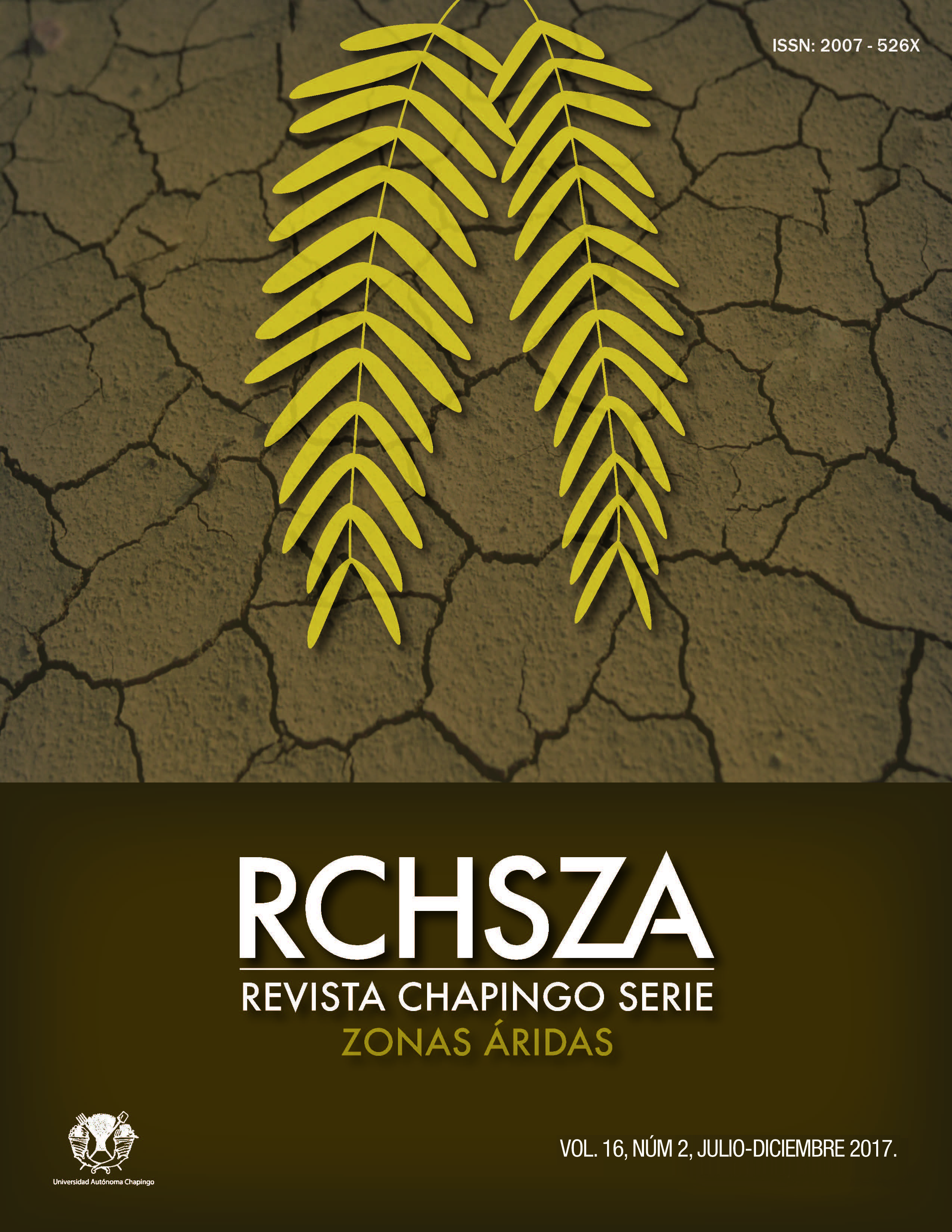Resumen
Los suelos alcalinos y calcáreos, típicos de las zonas áridas, limitan la disponibilidad de micronutrientes en el suelo para algunos cultivos. El objetivo del presente trabajo fue evaluar los contenidos de elementos menores en suelo y plantas de higuerilla cuando se usaron sulfato de amonio y dos tipos de biosólidos como fertilizantes. Los tratamientos se definieron al considerar tres fuentes (fertilizantes) y tres dosis de N, así como un testigo (sin fertilización). Las fuentes de N fueron sulfato de amonio (SA), biosólidos de plantas de tratamiento de agua residual con lagunas de oxidación (BLO) y con lodos activados (BLA). Las dosis de N fueron de 0 (testigo), 134, 200 y 260 kg∙ha-1. El diseño experimental fue bloques al azar con cuatro repeticiones. El rendimiento de materia seca y el contenido de aceite en semillas se incrementaron al aumentar las dosis de N. Las concentraciones mayores de Cu y Fe en el suelo después de la cosecha correspondieron a los tratamientos con BLO, con medias de 0.98 mg∙kg-1 de Cu y 5.20 mg∙kg-1 de Fe. Los resultados indican que los biosólidos utilizados en el presente trabajo aportaron los micronutrientes necesarios para un desarrollo adecuado de plantas de higuerilla, sin riesgo de toxicidad y contaminación.
Citas
Adair, K. L., Wratten, S., Barnes, A. M., Waterhouse, B. R., Smith, M., Lear, G., ...Boyer, S. (2014). Effects of biosolids on biodiesel crop yield and belowground communities. Ecological Engineering, 68, 270–278. https://doi.org/10.1016/j.ecoleng.2014.03.083
Akdeniz, H., Yilmaz, I., Bozkurt, M. A., & Keskin, B. (2006). The effects of sewage sludge and Nitrogen applications on grain sorghum grown ( Sorghum vulgare L .) in Va n-Tu rkey. Polish Journal of Environmental Studies, 15(1), 19–26.
Bauddh, K., Singh, K., Singh, B., & Singh, R. P. (2015). Ricinus communis: A robust plant for bio-energy and phytoremediation of toxic metals from contaminated soil. Ecological Engineering, 84, 640–652. https://doi.org/10.1016/j.ecoleng.2015.09.038
Danlami, J. M., Arsad, A., & Zaini, M. A. A. (2015). Characterization and process optimization of castor oil (Ricinus communis L.) extracted by the soxhlet method using polar and non-polar solvents. Journal of the Taiwan Institute of Chemical Engineers, 47, 99–104. https://doi.org/10.1016/j.jtice.2014.10.012
Jones, J. B., Wolf, B., & Mills, H. A. (1991). Methods of Plant Analysis and Interpretation. Micro - Macro Publishing, Inc.
Kominko, H., Gorazda, K., & Wzorek, Z. (2017). The possibility of organo-mineral fertilizer production from sewage sludge. Waste and Biomass Valorization, 8(5), 1781-1791. https://doi.org/10.1007/s12649-016-9805-9
Lange, A., Martines, A. M., & Antonio, M. (2005). Efeito de deficiência de micronutrientes no estado nutricional da mamoneira cultivar Iris. Pesquisa Agropecuária Brasileira, 40(1), 61–67.
Lavres Junior, J., Cabral, C. P., Rossi, M. L., Nogueira, T. A. R., Nogueira, N. de L., ...Malavolta, E. (2012). Deficiency symptoms and uptake of micronutrients by castor bean grown in nutrient solution. Revista Brasileira de Ciência Do Solo, 36(1), 233–242. https://doi.org/10.1590/S0100-06832012000100024
Lu, Q., He, Z. L., & Stoffella, P. J. (2012). Land application of biosolids in the USA: A review. Applied and Environmental Soil Science, 2012. https://doi.org/10.1155/2012/201462
Marschner, P. (2012). Marschner’s Mineral Nutrition of Higher Plants (3rd ed.). New York: Academic Press, Elsevier.Miller, R. W., & Donahue, R. L. (1995). Soils in our enviroment(Prentice H).
Ozores-Hampton, M., & Peach, D. R. A. (2002). Biosolids in vegetable production systems. Ho r t Techn olog y, 12(3), 336–340.
Pandey, A. K., Pandey, S. D., & Misra, V. (2000). Stability constants of metal-humic acid complexes and its role in environmental detoxification. Ecotoxicology and Environmental Safety, 47, 195–200. https://doi.org/10.1006/eesa.2000.1947
Perdomo, F. A., Acosta-Osorio, A. A., Herrera, G., Vasco-Leal, J. F., Mosquera-Artamonov, J. D., Millan-Malo, B., ...Rodriguez-Garcia, M. E. (2013). Physicochemical characterization of seven Mexican Ricinus communis L. seeds & oil contents. Biomass and Bioenergy, 48, 17–24. https://doi.org/10.1016/j.biombioe.2012.10.020
Rico-Ponce, H. R., Tapia-Vargas, L. M., Teniente-Oviedo, R., González-Avila, A., Hernández-Martínez, M., Solís-Bonilla, J. L., ...Zamarripa-Colmenero, A. (2011). Guía para cultivar higuerilla (Ricinus communis L.) en Michoacán.(1st ed.). Apatzingán, Michoacán, México.

Esta obra está bajo una licencia internacional Creative Commons Atribución-NoComercial 4.0.
Derechos de autor 2017 Revista Chapingo Serie Zonas Áridas




